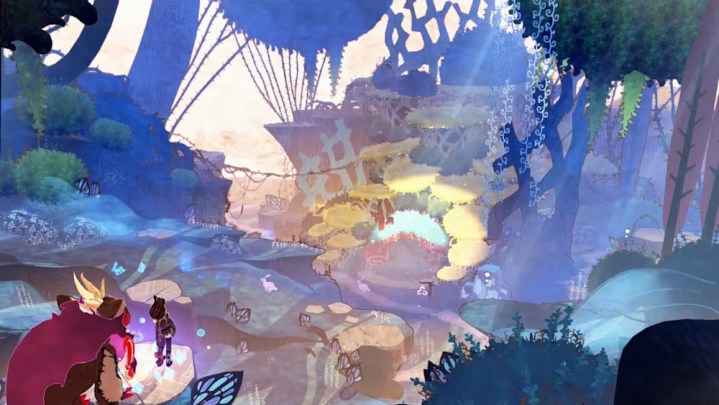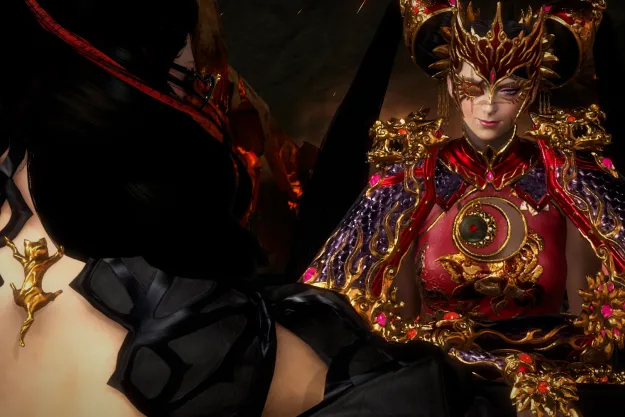I’ve played a ridiculous number of games in my lifetime, so it takes a special kind of experience to permanently stick in my mind. That’s the case with Okami, a 2006 adventure game that has had no real peers up until this point. Drawing inspiration from The Legend of Zelda series, Okami stands out in a crowded genre for its lovable wolf protagonist, memorable cel-shaded art style, and a wholly unique combat system that involves painting to slash enemies. For nearly two decades, I’ve been searching for an adventure game that can even approach its creative spirit and the way it gleefully plays with a well-trodden formula.
To my utter surprise and delight, Bayonetta Origins: Cereza and the Lost Demon might be that game.
After playing five chapters (a sizable chunk) of the unusual Bayonetta spinoff, I’ve found myself hooked on an adventure game that I had nearly written off within its first 10 minutes. That’s because the deeper I’ve gotten, the more I’ve had that Okami feeling while playing it. With its striking visual style, rewarding exploration, and a distinct battle system that takes a little time to get fully cooking, Bayonetta Origins is already feeling like the kind of game that’ll totally surprise players that go in with an open mind.
Give it a chance
On paper, Bayonetta Origins is a baffling project, and that left me with sour feelings as I began the game. The use of IP is admittedly baffling here, as the M-rated series about a witch who gets naked to cast spells is turned into a straight-up children’s game. For fans of the series, that fact might be hard to get over initially. Its opening chapter is an odd culture shock, as the world of Bayonetta is presented like a cute fairy tale complete with a storybook presentation. As I listened to a young Cereza run around the woods shouting in a squeaky voice, I kept asking myself, “Who is this for?”
I’m not sure that I fully know the answer to that after five chapters, but I can confidently say that my tune has changed with each passing chapter. That’s because Bayonetta Origins takes its time to show what it really is. At first, it seems like a short narrative adventure about a little witch wandering through a spooky forest with some simple controls and puzzles. The bulk of Cereza’s toolkit early on revolves around Witch Pulse, an object-altering spell that’s completed via a simple button-timing minigame. The early hours have me repeating that action a lot to grow plants that reward me with resources or build platforms.

The more I play, though, the more I’m delighted to discover a full-fledged traditional Zelda game with a unique twist. Once it opens up, I’m traveling around the woods with my cat demon, Cheshire, who can be controlled independently alongside Cereza. At any time, I can separate the two and control each on the left and right stick. Cereza’s Witch Pulse power is mapped to the left trigger, while Cheshire’s attacks and abilities are on all on the right Joy-con. Controlling two characters at the same time can always be a challenge, and it definitely takes some getting used to here, but the idea has already made for some clever environmental-puzzle solving.
Like Link in previous adventures, the duo here need to hunt down elemental MacGuffins hidden within loose dungeons and acquire abilities along the way. Those two ideas are actually linked, as each elemental sphere grants Cheshire a new form complete with various new powers. The first one I’m tasked with collecting gives the demon a grass form. When equipping that by simply pressing the Y button, I can use his vine-like tongue to grab objects. So far, I’ve used it to break open resource-carrying objects, drag train cars to solve platforming puzzles, carry bombs to break rocks, and more.

The more abilities I get, the more I can interact with parts of the forest I previously thought were just set dressing. At the end of chapter 5, I gain Cheshire’s second form, which turns him into stone. That ability has several uses too, as it lets the demon smash through unstable floors, break rocks, block lasers to let Cereza safely pass sections, ground-pound springy platforms, and much more. Each ability is like several Zelda items in one, so the game significantly evolves every time I grab a new one.
That setup makes for an adventure game that excels at momentum building, but also requires some patience to enjoy. The initially simplistic exploration has become much more engrossing the more I’ve played, and I’m already itching to see what Cheshire’s next two forms can do. That’s exactly the kind of feeling a good adventure game needs to keep the wonder alive from start to finish.
Solo co-op battles
That slow-build structure doubly applies to Bayonetta Origins’ combat. Battles are fairly simple early on. Cheshire attacks with the right trigger and Cereza can trap enemies in thorns with the left. A skill tree gives each some extra perks, but it doesn’t initially feel like there’s much depth beyond hammering Cheshire’s attack button while occasionally freezing an enemy. I was initially surprised to find such a straightforward system from PlatinumGames, a developer known for its complex action.
Like exploration, that entirely changes as I get more abilities. When I obtain Cheshire’s grass form, I can freely switch to it mi-battle and use his tongue to stun enemies or pry shields off of enemies. That instantly widens what I can do, making battles feel less like a one-button affair. The system cracks wide open, though, when I get my rock form. Pressing the right bumper lets Cheshire perform a body slam that can unearth burrowing enemies. Once I have three forms (including Cheshire’s neutral state), I’m quickly swapping between them to combo abilities together between strikes. Meanwhile, I’m using Cereza to trap enemies in thorns to help manage a busy battlefield.

Again, juggling two things at once can be tricky, but it can be thrilling once you get the hang of it. I can feel a spiritual link to Platinum’s excellent Astral Chain here that further experiments with that game’s solo co-op battle system. It seems like it’ll only get more engaging too. When I put it down at the end of chapter 5, I unlocked a much larger skill tree filled with extra moves. One ability would let me recall Cheshire to me by double-tapping the left bumper, doing damage to enemies on his way. Another would let me more fluidly swap forms in battle to keep up my combos.
All of this creative energy is where I come back to Okami. There are a lot of similarities on both games’ surfaces alone. Both have very distinct, illustrative visuals that present natural settings in a highly stylized manner, for instance. But it’s more so what Bayonetta Origins is doing within an old-school video game formula that flashes me back to Okami. Sure, that game follows the template of a Zelda game pretty closely, but it feels entirely different by playing around with how a wolf would interact with the world versus how a humanoid character would. That’s what I feel here anytime I learn a new Cheshire form and get to solve an environmental puzzle or take down an enemy in a way that feels entirely unique. Even Cereza doesn’t play like a typical adventure hero, using her Witch Pulse in tandem with Cheshire’s skills.
I’m not sure what awaits me in the second half of my adventure, but I’m excited to dive further down the rabbit hole. What I’ve found so far is a creative adventure game that feels like a genuine iteration of a classic idea, fusing old-school gameplay with the kind of forward-thinking design I expect from PlatinumGames. Have I come to understand why the voguing sex witch is now a children’s fairy tale hero? Absolutely not. But push your relationship to the IP aside and you might be surprised at what you find.
Bayonetta Origins: Cereza and the Lost Demon launches on March 17 for Nintendo Switch.
Editors' Recommendations
- The overlooked games of 2023: 11 sleeper hits you need to play
- The best video games of March 2023: Resident Evil 4, Tchia, and more
- Nintendo Direct February 2023: how to watch and what to expect
- Bayonetta 3 voice actress breaks silence amid casting controversy
- Bayonetta 3’s outrageous action has already cast a spell on me




